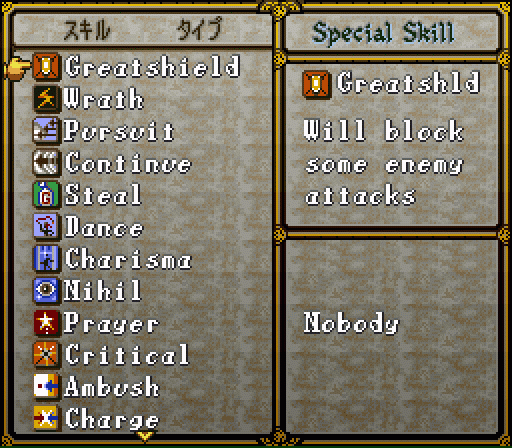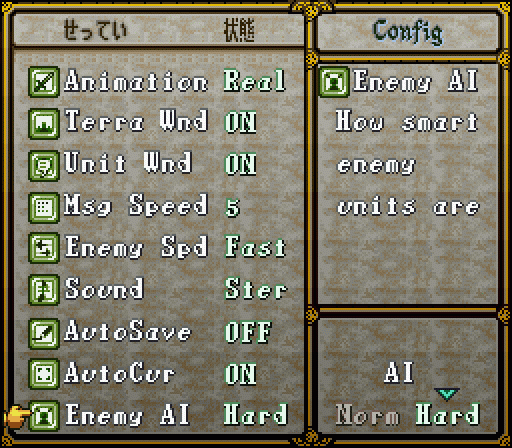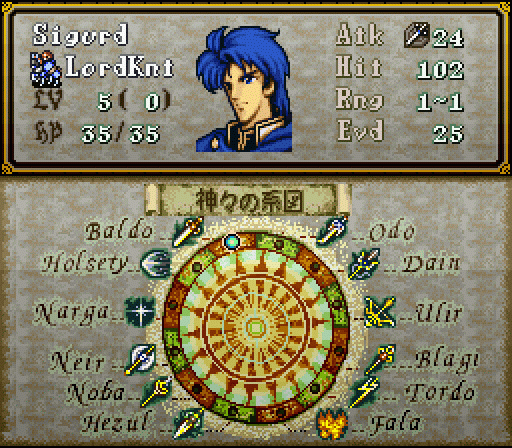Part 45: Stats, Skills, and Sounds
A more detailed explanation of some gameplay mechanics and miscellaneous things:So this'll deal more with the mechanics and formulas of the game. If you're familiar with this game other FE games, you can probably skip a lot of this, though there are some subtle differences with even some very basic formulas.
Stats explanation:
Str, Mag, Def, and Res all deal directly with how much damage a unit does in combat. Weapons also have a Might (Mt) stat that plays a role in this as well. A unit using a physical attack will do [Unit's Str+Weapon's Mt-Enemy's Def] damage, while a unit using a magical attack will do [Unit's Mag+Weapon's Mt-Enemy's Res] damage. An attack that hits will always do at least one damage, even if the defender had infinite defense.
Speed is used to calculate two things: A unit's Attack Speed (AS) which is equal to [Unit's Spd-Weapons Weight (Wt)], and a unit's Avoid (Avo) which is equal to [Speedx2+Lck+Terrain bonus +Leadership bonus +Charisma bonus +Lover bonus]. Wow that's a lot of bonuses. Ok a terrain bonus is dependent on what type of tile a unit is standing on. Meadows, sand, and ruins have a bonus of 0, road, bridges, and deserts have a bonus of -10 (meaning they actually make you lose avoid), villages and forests have a bonus of +20, mountains and castles have a bonus of +30, and deep forests have a bonus of +40. Next is the leadership bonus. Certain characters have leadership stars which translate to extra hit and avoid for teammates within three spaces of them. For example Sigurd has two leadership stars which translates to 10 extra hit and avoid. Characters with more stars will provide a bigger bonus. The Charisma bonus is the same as the leadership bonus, but it's always 10 and is dependent on characters having a certain skill called Charisma (hence the name). It still only applies in a three tile range. The lover bonus provides 10 extra hit and avoid when a character's lover is within three tiles of them.
Skill is used for two things as well: Accuracy (Acc) and Critical Chance (Crit). A unit's Acc is equal to [(Skill x 2) + weapon Accuracy + Leadership bonus + Charisma bonus + Lover bonus + Weapon triangle bonus]. Weapon Accuracy is a stat that all weapons have. In general Swords have more than Lances have more than Axes and C rank magic has more than B rank magic has more than A rank magic. The weapon triangle bonus is something we'll get into later. Luck is only used for calculating Avo.
Skills/options:

Now we're going to take a look at the UI for a bit. Unit will give us a list of all our units, their stats, skills, weapon ranks, anybody they can have conversations with, things like that. We'll see a bit more of that later. Item gives us a look of all the weapons and items our units hold. Nothing too interesting there. Data shows us how many turns have gone by in the chapter, as well as a list of all the armies currently on the field, whether they're allied or our enemy, who their leader is, and how many units they have. It's really not a very useful window. Skill gives us a look at all of the skills units can have as well as what they do.

Here's a little preview of the skills in the game, but I won't go over them now. Instead I'll go over each skill as they eventually come up in game.

Config gives us this options screen. Basic stuff like message speed, battle animations, etc. Something I actually found out this playthrough is that there's a difficulty setting for the enemy AI. I've never done Hard mode before, but I will in this playthrough, so it'll be a learning experience for both of us! Save lets us save our game at the start of each turn. This can only be done before a unit has moved. End ends the turn and switches the game over to the enemy phase.
Holy blood:

Here I'll add in a few brief things I left out in my initial explanation of holy blood. Every crusader has a holy weapon that relates to them and having major blood for that crusader allows that unit to use that holy weapon. In Sigurd's case, Baldo blood relates to the Tyrfing, but that won't show up for a while. There are three sword crusaders/holy swords (Baldo/Tyrfing, Odo/Balmung, Hezul/Mistoltin), two lance crusaders/holy lances (Dain/Gugnir, Noba/Gae Borg), an axe crusader/holy axe (Neir/Swanchika), a bow crusader/holy bow (Ulir/Ichival), a staff crusader/holy staff (Blagi/Valkyrie, not to be confused with the Valkyrie class in later FE games), and then a crusader and holy tome for each type of magic (Fala/Fala Flame, Tordo/Tor Hammer, Holsety/Holsety, and Narga/Narga, and yes the name of the tome is the name of the crusader for those last two).
Music:
Lastly, I'm going to take this time to gush over some of the music that's come up in this chapter so far. The track you heard in that video at the start of the episode (the one playing over the world map) is called Glorious Grandbell. That will be our map theme for the first generation of the game. We'll hear it between chapters as the game narrates some of what's going on. The map theme for this chapter, and every chapter for that matter, is the same as the chapter title: Birth of the Holy Knight (Orchestral arrangement). This is actually one of my favorite map themes. It really gives the player the feel that they're entering an epic battle. It's glorious, it's triumphant, really it's just fantastic. Aside from that, we also have the recruitment theme making its first appearance in this chapter. It plays basically whenever a new unit joins you, so you would've heard it during Lex and Azel's introduction as well as Cuan, Fin, and Ethlin's introduction. It's simply titled "Recruitment." Most of the tracks have very simple names like that. This game's recruitment theme is my favorite in the series. It's very snazzy and it's the first theme in the series that isn't a remix of the original recruitment theme from FE1. It was later remixed for the FE6 recruitment theme, but due to the sound quality on the GBA I've never liked that version as much.
Other tracks of note thus far are Beginning and the Fire Emblem Theme, both featured in the opening video, as well as Verdane Army, the theme that plays on Verdane's turn. Unlike other FE games that have a standard Enemy Phase theme or two, FE4 has a unique theme for each individual army. For the first two chapters all we'll hear is Verdane's theme, but later on we'll hear more.